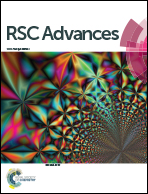Correlating the surface structure and hydration of a γ-Al2O3 support with the Run (n = 1–4) cluster adsorption behavior: a density functional theory study†
Abstract
The adsorption and nucleation behavior of Run (n = 1–4) clusters deposited on absolutely dehydrated and hydroxyl-modified γ-Al2O3 (100) and (110) surfaces were studied using density functional theory slab calculations. The results indicated that the adsorption process was strongly sensitive to cluster size and surface structure, with deformation and metal–support interactions apparently related. A single Ru atom preferred to adsorb on the (100) surface with small deformation energies, while small interaction energies led to the adsorption of Ru4 clusters on the (110) surface. When the surface was dehydrated, the adsorption of Run (n = 2–4) clusters on the (110) surface was substantially more stable than that on the (100) surface. The stronger acceptor and almost equal donor sites present on the dehydrated (110) surface increased the bidirectional electron transfer between the clusters and surface sites, resulting in lower adsorption and interaction energies. When the surface was hydrated, the introduction of hydroxyl groups lowered the Run (n = 2–4) clusters' adsorption ability on the hydrated (110) surface by decreasing the surface acidity and basicity, thereby weakening the driving force underlying electron transfer. However, for single Ru atoms, the opposite behavior was observed. In this case, the surface hydroxyl groups increased the stability of the adsorption of the Run (n = 1–4) clusters on the hydrated (100) surface as surface H acted as an adsorption site, receiving an electron from the Ru atom because of its strong Lewis acidity. Further, the support can stabilize the Run (n = 2–4) clusters by decreasing the binding energies of supported configurations lower than the corresponding gas phase. And the nucleation of Run clusters on all surfaces is thermodynamically favourable. The hydration of the (110) surface facilitates agglomeration of Ru4 clusters, while it is suppressed on the (100) surface. These results are relevant to understanding the interaction between surfaces and clusters.


 Please wait while we load your content...
Please wait while we load your content...